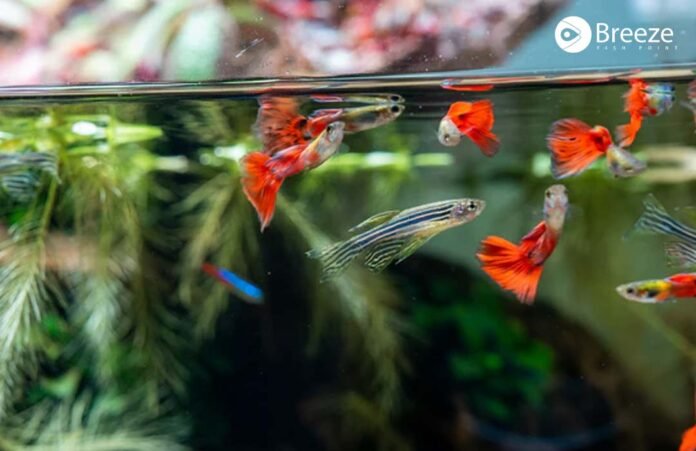1. Betta Fish
Betta fish more specifically known as the Siamese fighting fish is one of the most common choices for beginner betta enthusiasts. These fish are fairly tolerant and can live in small bowls, ideally, 5 gallons and above. They mostly do not need frequent attention as they have a tolerance limit for several aspects of water. Black halfmoon betta fish are recommended to keep them in a well-filtered tank with water temperature between 76-82°F or 24-28°C.
Food:
Betta fish require a protein-based diet, including betta pellets, blood worms, shrimp, and daphnia, but avoid overfeeding to prevent aquarium issues.
Did You Know?
Snails the beneficial for their snail mucin and are the best tank mates of betta fish which are aggressive fish.
2. Neon Tetra
Neon tetras are quite small and very peaceful with colorful stripes of blue and red. They do well in schools, and should therefore be kept in groups of not less than six. Tetra fish are reported to thrive well in slightly acidic water with a temperature range of 21-27 degrees Celsius, thus it is suitable for community tanks. Being small in size and non-aggressive in nature they are suitable for new aquarists, but they should not be placed with other aggressive fish.
Food:
Fish food for schooling fish are flake food, micro-pellets, and live foods like brine shrimp. Feed small portions or take two feeds daily to avoid waste.
3. Guppy
Some of the easiest fish to care for and therefore perfect for beginners are guppies because they are easy to care for and very colorful. Some of these livebearers are rather hardy and reproduce quite readily in the fish tank, incorporating more fish into your tank setups. Guppies prefer water temperatures ranging between 72-82°F as well as different types of water conditions.
Food:
Guppies should be fed a mix of sinking flake food, live/frozen shrimp, bloodworms, and plant-based food like spirulina flakes for a healthier diet.
4. Zebra Danio
Zebra danios are peaceful swimming fish and are quite easy to care for, making them great fish for novices. Distinguished by the black and white stripes, they are rather active expanding the overall energy in the aquarium. They are school fish and their best kept in groups of five or six. The recommended tank size for the Zebra Danios is a 30-gallon aquarium; however, it performs best in larger tanks of 50- gallons or more. They are adapted to a broad selection of water situations and recommended aquarium decoration plants with water temperature ranges between 64-77 °F (18-25 °C).
Food:
Zebra danios easily feed on plant and animal matter, including flakes, micro pellets, and live or frozen food. Feeding should be done twice daily, using small portions.
5. Corydoras Catfish
A type of fish known as aquarium cleaning fish otherwise called Cory cats is non-aggressive. It feeds on leftovers and also assists in cleaning the tank. Corydoras sometimes referred to as ‘cory catfish’ are shoaling fish and should be kept with at least 3 fish. Catfish has established that it loves to live in water with a temperature range of 70-78 F (21-26 C) and can live in small fish tank and the recommended tank has a soft sandy-like substrate that shields its barbels.
Food:
Corydoras anchor at bowels prefers sinking pellets, algae wafers, freeze-dried bloodworms, brine shrimp, and leftovers. They clean tanks and socialize with others.
6. Platy
Platys is a bright, freshwater fish that belongs to the livebearer family and is perfect for beginners because it requires no special conditions in the start tank. These fish are found in different colours and fades and this makes them to be attractive to the aquarium. Platys are very tolerant fish with no strict requirement to the water parameters although they prefer water temperature to be around 70-80°F or 21-27°C. As with guppies, these fish lay lots of eggs and are very easy to breed in an aquarium so you should expect fry if you have both boys and girls.
Food:
Platies are not picky eaters, fish tank auto feeder is best for them. They depend on flake foods, pellets, live/frozen foods like blood worms and brine shrimp, and vegetables like algae wafers or blanched spinach.
7. Mollies
They are rather unique fish in the process of aquarium rearing and breeding since mollies are quite adaptive to living conditions in freshwater as well as in slightly brackish water. They are also referred to as livebearers and therefore, similar to guppy and platy, are excellent for breeding. Mollies are available in many colors and sizes and some of them include black mollies and sailfin mollies. Set the aquarium with a Range of temperature preferred in 70-82°F (21-28°C) and water, ideally slightly hard, and alkaline with fish aquarium pump.
Food:
This fish should consume flake, pellet, algae wafers, blanched vegetables, frozen nutritious foods, vitamin-rich processed foods, and live foods like brine shrimps and blood worms.
8. Swordtails
Swordtails are colorful fish with a unique elongated dorsal fin giving them the name of their kind, swordtails. They are livebearers and in their reproduction process, they are very closely related to guppies and platys which makes the whole process very easy. Swordtails can however be considered as easy fish, which naturally dwell in water temperatures ranging from 72-82°F (22-28°C) common fish tank sizes are a minimum of 50L fish tank. They are not aggressive but get a little possessive, thus the fish should be placed in large tanks.
Food:
Swordtails are livebearers that primarily feed on flakes and pellets, occasionally consuming live and frozen food like blood worms and brine shrimp, and also enjoy plant-derived items like spirulina flakes.
9. Harlequin Rasbora
Harlequin rasboras are live-bearing fish, which are small in size and are regarded as passive fish, shaped like an oval, reddish-orange body with black markings. They are schooling fish and must be purchased in lots of five at least for them to be healthy. More importantly, they are rather easy to keep and therefore perfect for first-time aquarists. They like water temperature to be ranging from 72-81°F (22-27°C) and slightly acidic water.
Food:
Harlequin rasboras are omnivores that feed on flake food, Micro-pellets, zooplankton diet and occasionally live or frozen foods like Brine shrimps or Daphnia, recommended for small daily portions.
10. Cherry Barb
Cherry barbs are little, blood-red fish that give a colorful look to the aquarium. They are calm animals so not much effort is required in keeping them, unlike other aggressive animals which can be stressful if not well handled. Cherry barbs are aquarium shoaling fishes that are best maintained in groups of five or more fish. They prefer water temperatures ranging between 73-81°F (23-27°C) and simple aquarium decoration they can live in almost any water condition.
Food:
Cherry barbs are not picky eaters, consuming flakes, pellets, live/frozen food like bloodworms and brine shrimp, and occasionally feeding algae wafers.




